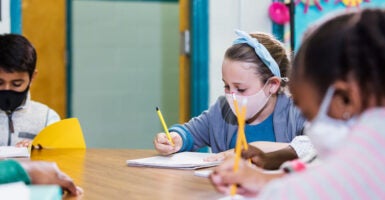All of us are trying to get used to the “new normal.” For some, it may be that be your company issued a work-from-home extension to 2021. Or it could be changing the majority of your medical appointments to use telemedicine or increasing the number of delivery services you use.
Many aspects of our lives have drastically changed because of the COVID-19 pandemic. Some changes are for the better, but many changes cannot be sustainable in the long term.
One area where a “new normal” has not been successful is the virtual education that many school districts are using. Keeping students behind a laptop and away from the socialization of a classroom is not working for students or parents.
>>> What’s the best way for America to reopen and return to business? The National Coronavirus Recovery Commission, a project of The Heritage Foundation, assembled America’s top thinkers to figure that out. So far, it has made more than 260 recommendations. Learn more here.
As a father with a young kindergartener, I have experienced firsthand the difficulties so many parents are facing as we try to assist our kids with virtual learning.
This shift to virtual education is incredibly difficult on our young ones, who deserve access to in-person education, and on their parents or guardians who must act as a caretaker while juggling their own full-time jobs.
Relying on virtual learning is having a dramatic impact on the economy’s ability to rebound. During a recent hearing hosted by the Joint Economic Committee, on which I serve as the senior House Republican member, I asked economist Austan Goolsbee if schools and day care closures are a barrier to our economic growth. He replied, “100%.”
Across the country, unemployment remains well above the 50-year lows recorded earlier this year. Entire economic sectors are still unable to safely reopen or return to full capacity. Without schools opening, many parents, particularly those in low-income households, are unable to return to full-time jobs.
Right now, lower-income parents are expressing more concern about their children potentially falling behind those in higher-income groups. Parents who are fortunate enough to have the option to work from home are placed in an impossible situation: to simultaneously work while providing full-time child care.
It should be a top priority nationally to allow children to return to in-person learning, as many parents are not able to stay at home and help their children access online learning full-time.
Only 16.2% of Hispanic workers and 19.7% of black workers can telework, making it nearly impossible for many parents to stay at home daily. Too many parents, especially mothers, are being forced to choose between staying employed and supporting their child’s education.
We cannot expect parents to adapt to this new normal, where the choice comes down to providing for your family financially or assisting your children as they try to learn online in a home setting.
Another recent study shows that 14% of households with children had food insecurity in 2018, well before the pandemic erupted. Today, children who depended on school meals are unable to receive them in communities across the country.
There are some bright spots, however. Some schools have managed to reopen their doors for a safe return of in-person learning—not only for their students, but for faculty. Just one week after my daughter started hybrid learning, we noticed a stark difference in her happiness being with her peers at school.
We are encouraged to see that the administration is deploying 150 million Abbott BinaxNOW rapid COVID-19 tests to states. States across the country must prioritize making these tests readily available in our schools, to help protect students and educators.
If schools continue to stay closed, we will see long-term side effects. Although we don’t have an accurate prediction of the societal damage caused by COVID-19, our top priority needs to be making sure that we do not continue to damage our country following the mass shutdown of the economy.
Children need to be able to return to their pre-COVID-19 learning environments immediately to ensure that we can educate our youth and support our labor force, both financially and mentally.
Even amid our differences, all Americans are hoping to return to normal following the global pandemic. Many of us never have experienced times like this, and although we have overcome many of the challenges brought upon us in 2020, reopening schools for America’s children is the most important step we need to take.































